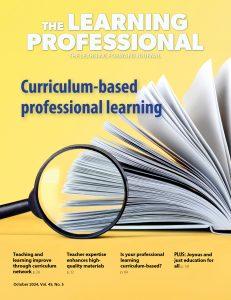According to the 2015 National Survey on College and Career-Ready Literacy Standards and Collaborative Professional Learning, 91% of teachers surveyed report working on standards implementation during collaborative time with colleagues, with 77% rating it valuable or extremely valuable in supporting their transition to new literacy standards.
73% of teachers who report having regular time to collaborate feel better prepared to implement the standards. And yet more than 80% of teachers report having fewer than two hours a week to collaborate.
If we agree with the simple supposition that time and collaborative learning experiences are key to successful implementation, then how do we ensure that more teachers have what they need?
Research has confirmed many times that leadership is second only to teaching in influencing student achievement. In my view, when our goals include equity and excellence, leadership may be even more important.
What do system and school leaders do that teachers value most and identify as most helpful in their efforts to ensure high-quality literacy and standards-based instruction for all students? According to the survey results and confirmed by research, system and school leaders:
- Establish a vision for high-quality instruction. Leaders engage staff and colleagues in refining that vision so that it translates all the way to what happens between teachers and students.
- Share leadership on key issues impacting instruction. Leaders engage teachers in examination of data, determine priorities as they relate to ensuring all students master literacy standards, and identify the professional learning they need most to achieve the outcomes they want for students.
- Tap the expertise of their best teachers. Leaders recognize that solutions to their most challenging problems may reside within their staff, so they look there first. If further expertise is necessary, they involve the staff in deciding where to look.
- Make collaborative time a priority and remove the barriers to it. Leaders eliminate excuses and find ways to create schedules that prioritize collaborative learning time. They provide support so teachers can use learning time wisely to solve problems tied to their highest student learning priorities.
- Behave as the chief learner and model all the practices they ask of colleagues and staff. Leaders learn alongside teachers and, in particular, engage in professional learning with teachers so they learn how to observe and provide feedback that will be most helpful. They also seek opportunities to learn with other leaders in other buildings and districts.
According to the National Center for Literacy Education survey results, teachers thrive in schools that prioritize these literacy capacity-building strategies and, in turn, students have greater opportunities for success.
These actions are small in number but very important things that system and school leaders do and teachers value most. When leaders are successful at these five things, they ensure that teachers have the opportunities they need to develop competence in teaching literacy and new standards. They also ensure that best practices spread from classroom to classroom and school to school.
That is why leadership is essential to achieving the goals of equity and excellence for all.
This post originally appeared in Learning Forward’s PD Watch.
NCLE’s report, Building Literacy Capacity: The Conditions for Effective Standards Implementation, details the findings from a large-scale national survey completed in spring 2015 in cooperation with NCLE’s 25 stakeholder groups from across the education spectrum. Read the full report here.






